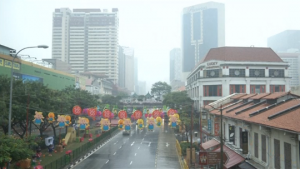
(Reuters) — Heavy rain showers on Tuesday (September 15) gave Singapore residents hope that the choking haze shrouding the city state will improve.
Indonesia has ordered a crackdown against those responsible for the fires lit to clear forested land which has created a choking smog that is spreading across neighbouring countries which is showing no sign of abating.
In Singapore, the air quality index has fluctuated above 100 PSI (Pollutant Standards Index), levels considered “unhealthy”, for the past few days, with the poor air quality causing respiratory problems, and irritating eyes and throats.
But residents like Mr. Guo said they felt better after the downpours.
“During the last few days, yes, it was difficult to breathe, (but) it is better now. (The haze) is nothing much now,” he said.
Some tourists said the level of pollution was initially alarming.
“I got used to it but when I first saw it I was a bit shocked because it’s like, not too common in Europe, but you get used to it,” said German tourist Sebastian Tideman.
The blanket of haze has raised concerns over the impact it might have on the city’s upcoming Grand Prix, and race organizers are monitoring the situation in case it worsens and affects driver visibility.
The fires have been exacerbated this year by the effects of the El Nino weather phenomenon, as a prolonged dry season in Indonesia has parched the top soil, fuelling the flames.
Indonesia has struggled for years to contain forest fires and the resulting haze despite repeatedly promising to punish perpetrators.
Indonesia’s Riau province declared a state of emergency this week after the air quality index hit a “dangerous” high of 984 PSI in the provincial capital and affected over 25,000 people, according to the National Disaster Management Agency.






